Reply To:
Name - Reply Comment
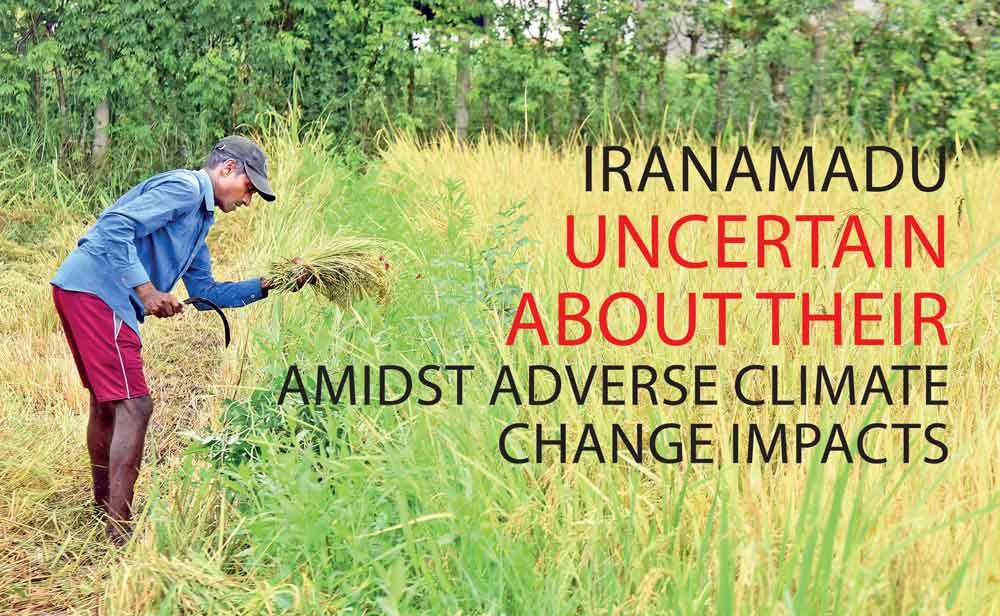
Agriculture is one among 15 other sectors that would be impacted due to adverse climate change conditions
| Farmers lack sufficient knowledge on climate change conditions which would affect their harvests |
Paddy farmers across Sri Lanka are continuously challenged by adverse climate change impacts which have directly affected their overall paddy yield. Farmers in rain-fed cultivation areas such as Iranamadu, Kilinochchi complain that they experience sporadic rains during season and off season in addition to prolonged-drought conditions ultimately reducing their harvests. Agriculture is now being considered as one among 15 other sectors that would become vulnerable in the face of climate change. While farmers contemplate abandoning their paddy lands due to existing challenges, the new government has promised to improve the lives of farmers once they gain a majority in Parliament.
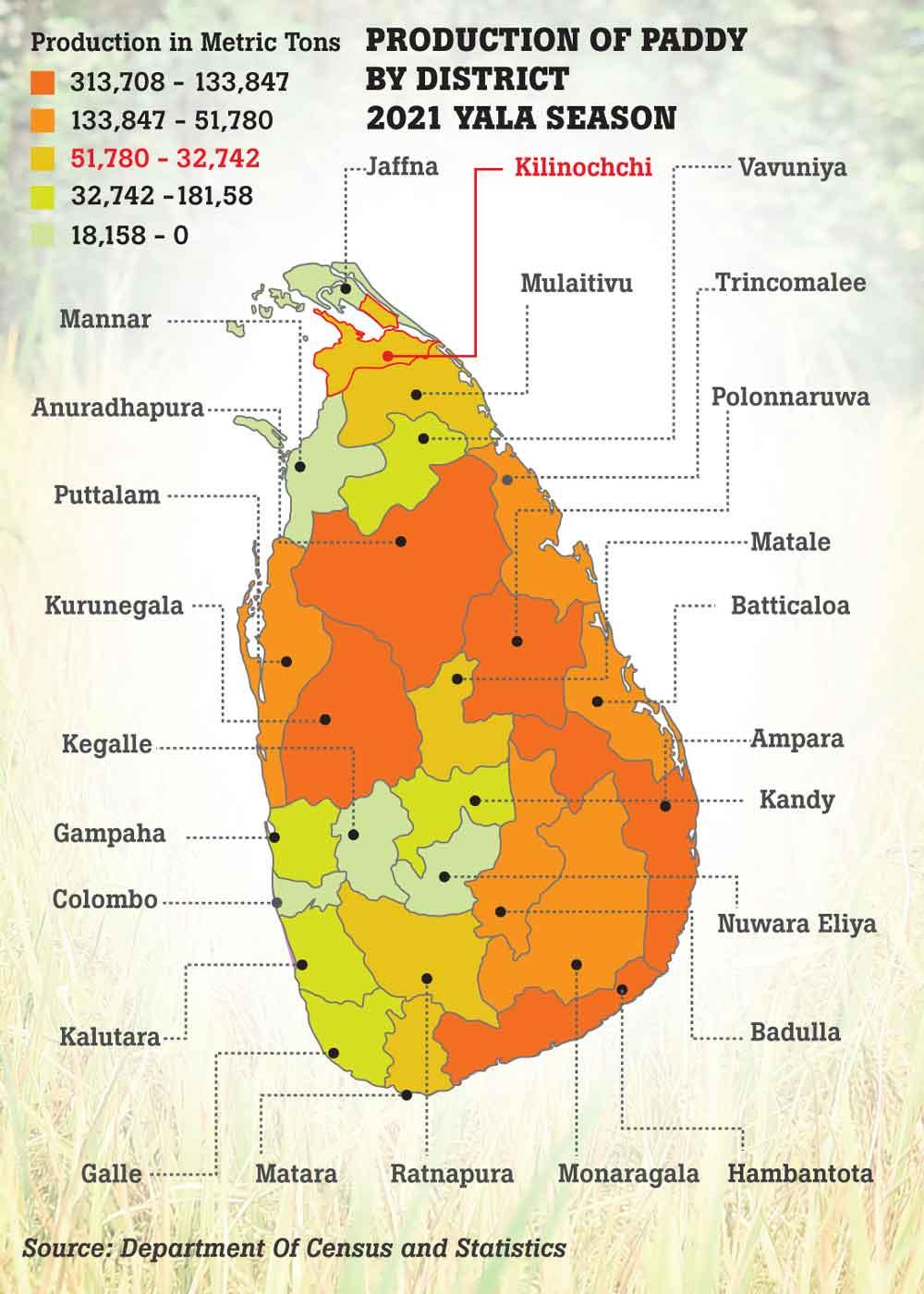
Widening gaps between authorities and farmers
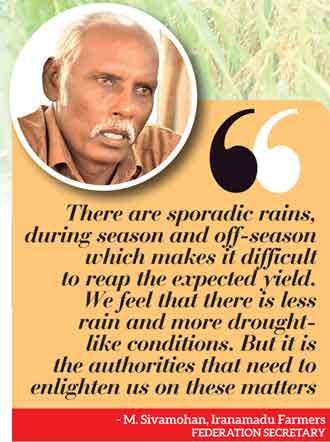 Even though agriculture is a main source of income for people in Kilinochchi, farmers claim that they haven’t received sufficient support from successive regimes. In addition, this newspaper learned that farmers lack sufficient knowledge on climate change conditions which would affect their harvests. “There’s no doubt about climate change patterns,” said M. Sivamohan, Iranamadu Farmers Federation Secretary. “We have observed prolonged drought and heavy rainfall. There are sporadic rains, during season and off-season which makes it difficult to reap the expected yield. We feel that there is less rain and more drought-like conditions. But it is the authorities that need to enlighten us on these matters,” he added.
Even though agriculture is a main source of income for people in Kilinochchi, farmers claim that they haven’t received sufficient support from successive regimes. In addition, this newspaper learned that farmers lack sufficient knowledge on climate change conditions which would affect their harvests. “There’s no doubt about climate change patterns,” said M. Sivamohan, Iranamadu Farmers Federation Secretary. “We have observed prolonged drought and heavy rainfall. There are sporadic rains, during season and off-season which makes it difficult to reap the expected yield. We feel that there is less rain and more drought-like conditions. But it is the authorities that need to enlighten us on these matters,” he added.
Many farmers can no longer bear exorbitant costs to produce the expected yield of paddy. “We received Rs. 6,000 as compensation when the organic fertiliser fiasco happened, but a bag of chemical fertiliser costs around Rs. 9,000 and we need three bags of fertiliser to cultivate one acre. Therefore Rs. 6,000 is a pittance and it is not even sufficient to cover the labour costs,” Sivamohan claimed further.
The Daily Mirror also learned that farmers have to overcome communication hurdles when they attend agriculture meetings in Colombo. “I travel around 300 km to reach Colombo when there are meetings at the Ministry. But there is nobody to translate our issues. They can’t understand Tamil and I can’t speak in Sinhala. So even that attempt had been a waste of time,” he claimed further.
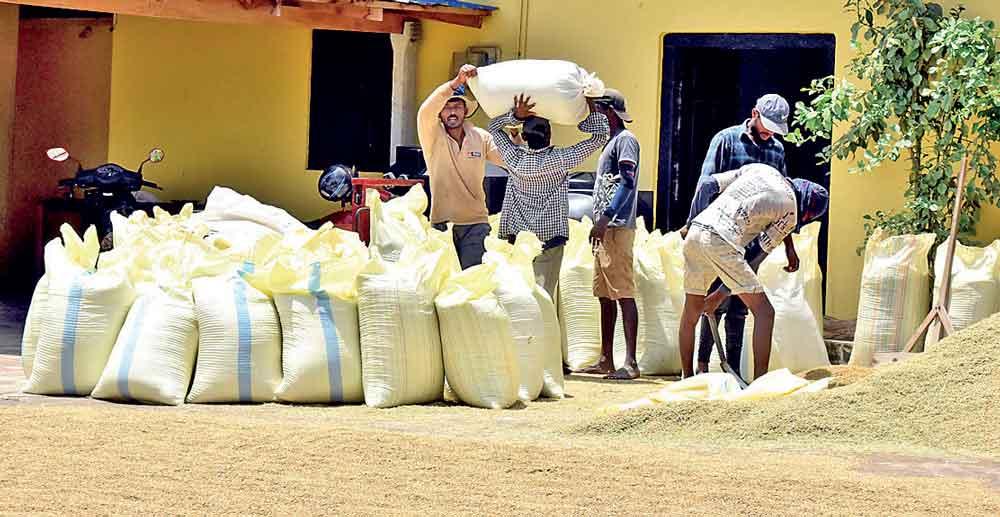
Paddy farmers in Kilinochchi grow paddy during intermediate seasons to earn an additional income
Dearth of research
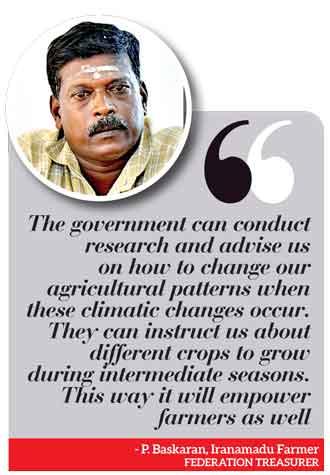 “It costs around Rs. 150,000-200,000 to grow one acre of paddy and we have to depend on a loan. But if we fail to pay it on time, the banks give us a hard time,” said P. Baskaran, Iranamadu Farmer Federation Treasurer.
“It costs around Rs. 150,000-200,000 to grow one acre of paddy and we have to depend on a loan. But if we fail to pay it on time, the banks give us a hard time,” said P. Baskaran, Iranamadu Farmer Federation Treasurer.
He further claimed that none of previous regimes have done research in these areas to introduce new weedicides or chemicals to crops. “They should consult us regarding these issues. Farmers are clueless about what type of chemicals to use and they purchase these items like purchasing over-the-counter drugs. The same applies to climate change patterns as well. The government can conduct research and advise us on how to change our agricultural patterns when these climatic changes occur. They can instruct us about different crops to grow during intermediate seasons. This way it will empower farmers as well,” he added.
Farmers anticipate a new lease of life
After facing various challenges, farmers anticipate a better sale of their paddy. But even before the paddy reaches the market, the middlemen come into the picture. “During the paddy harvesting seasons they would import rice from overseas and this poses a significant challenge for paddy farmers to sell their paddy. Laws need to be in place to stop such practices. We were able to sell keeri samba at Rs. 9,000 per bag, but now it has reduced to Rs. 6,500 per bag. The middlemen collect our harvest, pay us a pittance and sell this paddy at higher prices gaining higher profits,” said S. Yatheeswaran, President of the Iranamadu Farmer Federation.
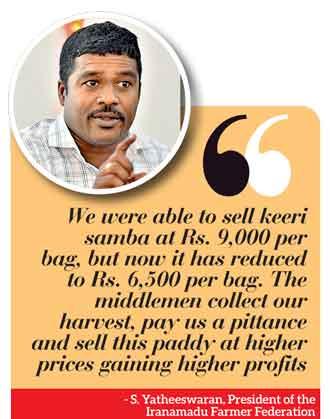 Even though youth unemployment is a serious social issue in Kilinochchi, the youth are not interested in agriculture. The Daily Mirror learned that many young farmers have abandoned their paddy lands and have migrated as they can’t find a handsome income from paddy farming. “The senior population is still engaged in farming practices but we don’t know what will happen afterwards. Some youth have gone to Colombo to work as masons, carpenters etc.,” Yatheeswaran added.
Even though youth unemployment is a serious social issue in Kilinochchi, the youth are not interested in agriculture. The Daily Mirror learned that many young farmers have abandoned their paddy lands and have migrated as they can’t find a handsome income from paddy farming. “The senior population is still engaged in farming practices but we don’t know what will happen afterwards. Some youth have gone to Colombo to work as masons, carpenters etc.,” Yatheeswaran added.
Another worry among farmers is that their children have been unable to find jobs despite being graduates. The North of Sri Lanka is home to over 4,000 unemployed graduates and farmers weep over the fact that none of the governments have been able to establish a stable future for their children. “It is not like they can engage in coolie work after becoming graduates. We have spent so much on their education, but they are unemployed even after completing their studies. We don’t want to be marginalised anymore and it is high time that the government appreciated the role played by farmers,” Yatheeswaran said while adding that the authorities should now consider including Kilinochchi as one of the main paddy growing regions in the country apart from Anuradhapura, Polonnaruwa, Hambantota, Kandy and Ampara.
Enhanced climate
change impacts
 “Irrespective of the government in power, climate change continues to happen,” said Prof. Buddhi Marambe, Senior Professor in Crop Science, Faculty of Agriculture at Peradeniya University. “Even though climate change has been happening naturally due to industrial revolution and unprecedented emissions of greenhouse gases, climate change has taken place at a pace which we have never expected before. In other words, all our efforts right now is not to stop climate change but to make sure the rate at which it is happening will be minimised to the maximum possible extent.”
“Irrespective of the government in power, climate change continues to happen,” said Prof. Buddhi Marambe, Senior Professor in Crop Science, Faculty of Agriculture at Peradeniya University. “Even though climate change has been happening naturally due to industrial revolution and unprecedented emissions of greenhouse gases, climate change has taken place at a pace which we have never expected before. In other words, all our efforts right now is not to stop climate change but to make sure the rate at which it is happening will be minimised to the maximum possible extent.”
He explained about the enhanced climate change impact due to greenhouse gas emissions. “Thanks to greenhouse gases, the surface and air temperature is at a level where life can survive. If not for greenhouse gases, world temperature would have been in the region of -16 to -880C. In that range, no life can survive,” he added.
Speaking about the agriculture sector, Prof. Marambe said that Sri Lanka has identified 15 sectors that will become vulnerable in the face of climate change. “There are losses and damages caused by climate change which is a cross-cutting issue and whichever the government in power needs to pay more attention to make sure the impact will be felt at the lowest possible level. Suppose that they say climate change is zero, the impact due to climate change that has taken place over the years will be felt by people for the next 40-50 years. This is why the Paris Agreement that came into effect in 2016 very categorically said that all our efforts should be geared towards making sure the increasing temperature based on what was there in the pre-industrial era will be less than 20C by the end of the 21st century. According to the National Adaptation Plan for Sri Lanka, one of the main sectors that would be adversely affected by climate change is agriculture. Others include water, fisheries, human health, ecosystems and biodiversity among others.”
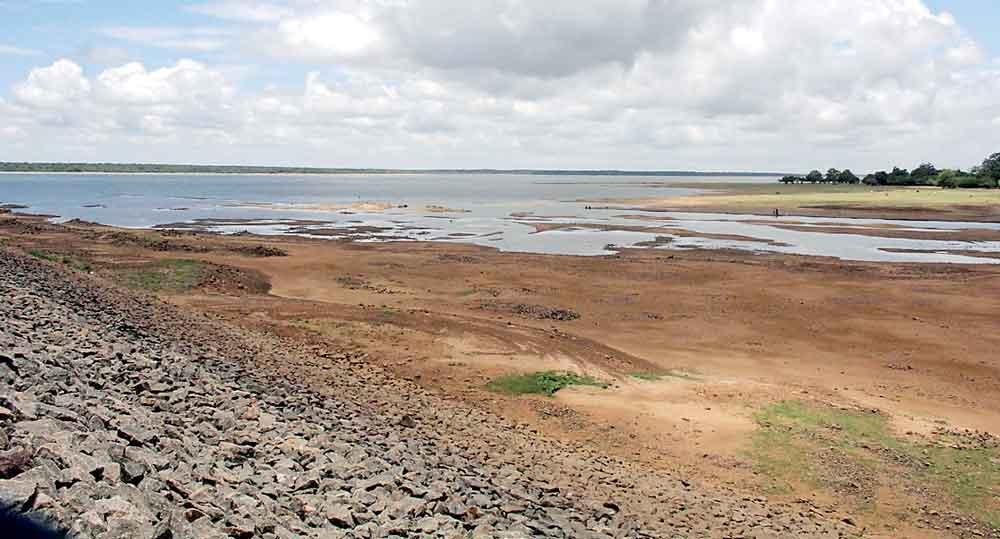
The Iranamadu tank provides water to over 7000 families in Kilinochchi but water becomes a scarcity during prolonged drought conditions
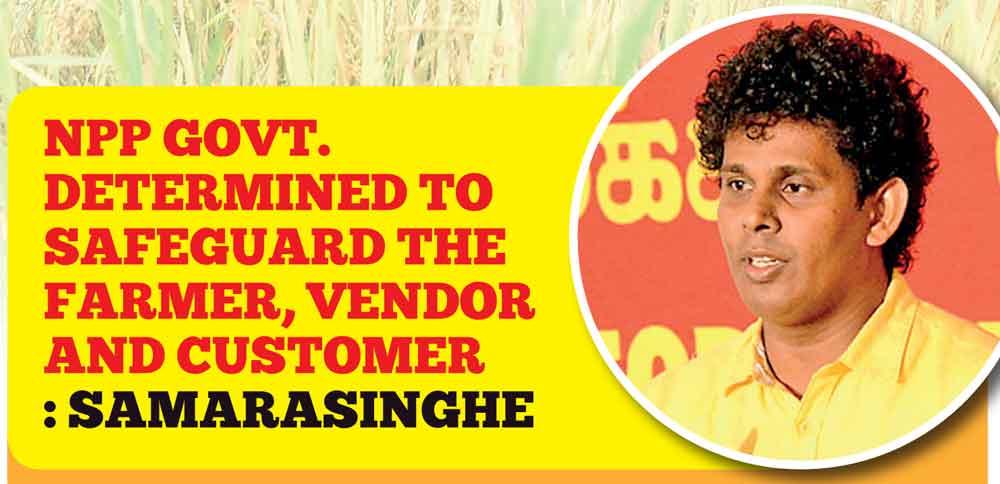
President Dissanayake’s manifesto aims to increase the paddy yield by 6 metric tonnes per hectare. Challenges outlined in the document include subsistence farming, minimal mechanisation, high production costs, insufficient prices for production, high prices and price volatility of agricultural products, weak extension services, inadequate value addition and low youth participation. Some of the progressive steps include maintaining a real-time national agricultural database, a systematic agricultural insurance system for farmers and solutions to minimise crop damage. Speaking to the Daily Mirror, National People’s Power member Wasantha Samarasinghe said that plans are afoot to appoint a committee and discuss district-level issues pertaining to the agriculture sector. “Here they will discuss intermediate crops, fertiliser and other facilities and will also recommend suitable markets for farmers. But all these will be implemented once the NPP gains a majority in Parliament. Until then, we will maintain the existing activities. We have already published our National Development Plan and this is why people should vote us in at the next election to allow us to implement what we promised.”
When asked about the interference of middlemen in the paddy sector, Samarasinghe said that there had been a persistent issue with selling paddy at a desired price. “Farmers are unable to gain profits because there’s a gap between the production cost and the selling price. So we will implement a process where the farmer, vendor and the consumer will be safeguarded against any sort of corruption,” he added.
Lack of climate communication
Prof. Marambe further said that Sri Lanka lacks climate communication approaches and therefore whatever the research done by the government doesn’t get communicated to the farming communities and the general public. “Farmers know that there are changes in rainfall, temperature is increasing and they know they are becoming vulnerable every day, but they don’t know at what level and what needs to be done. For example, the Ministry of Environment established a climate change secretariat in 2008. They have published many publications in all three languages in simple form which includes predictions, projects based on the forecast that we have and the solutions. But naturally only a few people would visit these websites,” Prof. Marambe added.
Prof. Marambe further spoke about efforts taken by the Department of Agriculture to provide feasible solutions to the farming community to respond to climate change impacts. “Take paddy for example, we are towards the latter part of the Yala season and the Maha season will begin somewhere between mid to third week of next month. The Department of Agriculture has already developed drought tolerant paddy varieties. The first drought-tolerant paddy variety developed in this country is called BG 251.”
Research indicates that around 35% farmers engaged in rain fed rice cultivation abandon their paddy lands due to insufficient water. BG 251 is a 2.5 month aged Nadu variety. “There are three other drought escape paddy varieties which will provide a yield as quickly as possible. The drought tolerant variety will give a yield even with an ongoing drought. The Department is also experimenting new water saving techniques, especially for upland cultivation such as micro-irrigation, drip irrigation systems to ensure that the limited amount of available water is being used in the best possible way through a more targeted mechanism. This is called precision agriculture. In addition, rainwater harvesting systems are also in place,” he said while adding that the selection of paddy varieties, agronomic packages and improving land productivity in a variable climate would be some of the challenges ahead.
Additional reporting and translations by E. Vettimor andT.K Mansoor.
This story was produced with the support of InterNews
Pix by Kithsiri De Mel